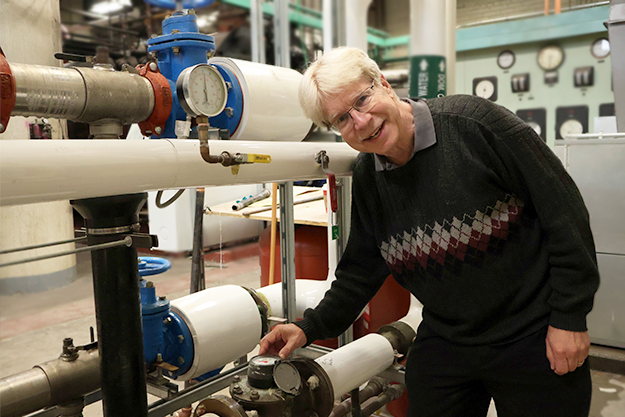Get to know F&S: Gordon Berthin
For the past 14 years, Gordon Berthin has been a vital part of the University of Toronto's Facilities and Services (F&S) team, working diligently in a technical support capacity. Berthin's career at U of T has spanned a wide variety of responsibilities, a testament to his dedication, adaptability, and passion for ongoing learning.
Berthin’s primary responsibilities revolve around utilities metering—tracking the consumption of natural gas, and water as well as managing stormwater. He also tracks the use and output of the Central Steam Plant, which provides steam for heating, cooling, and other essential functions on campus.
“Each month, it’s crucial to know how much steam is needed to ensure spaces are properly heated and there is enough supply of high temperature water, so my job involves managing the steam meters and sending the data to accounting,” he explains. In addition, he provides to the utilities group, provides input into project documentation, and ensures that natural gas supplies are allocated accurately.

“Anything AutoCAD is fair game. I’ve drawn steam meter installation plans, utility pipe runs, pipe support systems, expansion joints, and control room floor plans. But mainly, I focus on maintaining the campus-wide utility tunnel drawings. These are essential for troubleshooting, planning expansions, and organizing maintenance and repairs,” he says, “and there are more than three kilometres of tunnels on campus, so it’s a big job!”
Reflecting on the technological advancements during his career, Berthin is most proud of streamlining data collection processes. “We used to manually type and retype numbers, which was a time-consuming and error-prone procedure. Automating this has greatly improved efficiency and accuracy,” he says. “And with AI advancements, voice recognition accuracy has skyrocketed. Now, many of our reports are dictated, making documentation highly efficient,” he says. “This technology has significantly improved our workflows.” These days, efficiency is everything: “The University feels so much bigger now , both in terms of buildings and the number of utilities we manage,” Berthin says.
Berthin notes that the technology he supports has become more sophisticated recently. “As new buildings are added, more meters need to be tracked,” he says. The Landmark geoexchange—a part of the campus-wide Project Leap emissions reduction initiative—will use a geothermal energy for heating. “It’s exciting and challenging,” Berthin enthuses. “This new system will be a game-changer; it will be crucial to operate it efficiently and calculate energy extraction accurately.”
When not at work, Berthin enjoys swimming, bicycling, and stamp collecting—and his function as treasurer at his church has provided useful insights that he brings to the table at F&S. He is also fascinated by ancient texts, particularly the undeciphered rongorongo script from Easter Island.
“Thanks to the U of T’s excellent library resources, I’ve been able to conduct extensive research on this topic,” Berthin says. In August, he will attend the Writing and Cognition in Interdisciplinary Perspective conference in Ascona, Switzerland to present his findings in a presentation entitled “A Study of Analogous Glyph Forms and Their Possible Roles in Rongorongo.”
Looking to the future, Berthin is excited about U of T’s commitment to becoming climate positive by 2050. “This will involve a major shift in how we operate our utilities, possibly transitioning to electric heating instead of natural gas,” he envisions. Despite the hurdles that lie ahead, he remains optimistic about future breakthroughs and inventions.
